While I don't have all the kinks out of my piping system yet, this pump will be saving me a lot of electricity. I just checked and when the pump is operating at 45gpm it draws 1,860 watts but when I drop it to 35 GPM the wattage drops all the way down to only 1,140. I was running last night at 25 gpm and I think the electric usage was around 700 watts.
I'm impressed with my new Intelliflow Pump!!
- Thread starter kirbinster
- Start date
You are using an out of date browser. It may not display this or other websites correctly.
You should upgrade or use an alternative browser.
You should upgrade or use an alternative browser.
How many returns do you have and what are the size of the eyeballs you are using? Also, are your returns 1 1/2 or 2 inch pipe?
I haven't started to hook my pump up yet, but since the pool and lines are 25 years old, I am going to stay at about 30 gals a minute during the day and as low as I can go at night. I'm hoping it will get down to about 10 to 15 gals a minute.
I have to repipe my pool shed for 2 inch lines. I'm just waiting for my fittings to get here.
Mean while, there is lots of yard work to do. :lol:
I haven't started to hook my pump up yet, but since the pool and lines are 25 years old, I am going to stay at about 30 gals a minute during the day and as low as I can go at night. I'm hoping it will get down to about 10 to 15 gals a minute.
I have to repipe my pool shed for 2 inch lines. I'm just waiting for my fittings to get here.
Mean while, there is lots of yard work to do. :lol:
I have a pair of 1.5" returns and I think the eyeballs have 1" openings. I also have another 1.5" line that feed a pair of 2' by 20" solar mats that dumps into the pool that I manually valve in during the day an partially close of the other two return lines to push water through the panels. The wattage I was measuring is based on the panels being in operation.
I also have a heat pump, so I try to keep flow up enough for it to operate - but I have not figured out how low I can get the flow and have it stay on line yet.
Why do you want to run high flow during the day and low flow at night? My goal once I have the temperature up (it started at 47 on Tueday and is 65 now) is to do the exact reverese. We have time of day electric pricing so power is much cheaper at night than during the day. My plan is to run at about 10 gpm during the day to make use of the solar panels and then do my main circulation using off-peak power.
BTW- if you run at 30gpm for 12 hours that would only be 21,600 gallons and then 12 hours at 10gpm would be another 7,200 gallons which is probably less than one turn over of your water in 24 hours -- I think you will need a higher flow rate that that.
I also have a heat pump, so I try to keep flow up enough for it to operate - but I have not figured out how low I can get the flow and have it stay on line yet.
Why do you want to run high flow during the day and low flow at night? My goal once I have the temperature up (it started at 47 on Tueday and is 65 now) is to do the exact reverese. We have time of day electric pricing so power is much cheaper at night than during the day. My plan is to run at about 10 gpm during the day to make use of the solar panels and then do my main circulation using off-peak power.
BTW- if you run at 30gpm for 12 hours that would only be 21,600 gallons and then 12 hours at 10gpm would be another 7,200 gallons which is probably less than one turn over of your water in 24 hours -- I think you will need a higher flow rate that that.
Another data point, I was running at 30 gpm with my returns slightly closed to force water through the solar panels - that was drawing 950 watts. I then opened the return valves full but left the solar valved in, the flow shifted mostly away from the panels - just a small flow through them and the wattage dropped to 860 watts at the same 30 gpm
Thise readings sound a little high. What pressure are you running at the discharge of the pump? I have a 1.5 Hp two speed pump that at high speed consumes about 1.1 KW (1100 watts). At high speed according to the pump curve I am getting 75 gpm.
I have a Pentair Intelliflow (variable flow). As a point of comparison, with my solar off, I get the following GPM, RPM, Wattage:
15 GPM, 1175 RPM, 155 Watts
19 GPM, 1340 RPM, 200 Watts
24 GPM, 1400 RPM, 232 Watts
26 GPM, 1495 RPM, 275 Watts
30 GPM, 1535 RPM, 295 Watts
48 GPM, 2350 RPM, 865 Watts
With the solar on I get the following:
42 GPM, 2750 RPM, 1180 Watts
48 GPM, 2980 RPM, 1500 Watts
54 GPM, 3315 RPM, 2050 Watts
My solar system is large, on the roof with long runs and lots of turns, away from the pump & pool. So I agree that the non-solar numbers sound high from kirbinster and that the small difference between solar on/off doesn't sound right. The pipe leaving my pump is 2" whereas this splits into 1.5" to 3 returns. The suction line is 1.5" to dual floor drains and one skimmer. I have an oversized cartridge filter.
Richard
15 GPM, 1175 RPM, 155 Watts
19 GPM, 1340 RPM, 200 Watts
24 GPM, 1400 RPM, 232 Watts
26 GPM, 1495 RPM, 275 Watts
30 GPM, 1535 RPM, 295 Watts
48 GPM, 2350 RPM, 865 Watts
With the solar on I get the following:
42 GPM, 2750 RPM, 1180 Watts
48 GPM, 2980 RPM, 1500 Watts
54 GPM, 3315 RPM, 2050 Watts
My solar system is large, on the roof with long runs and lots of turns, away from the pump & pool. So I agree that the non-solar numbers sound high from kirbinster and that the small difference between solar on/off doesn't sound right. The pipe leaving my pump is 2" whereas this splits into 1.5" to 3 returns. The suction line is 1.5" to dual floor drains and one skimmer. I have an oversized cartridge filter.
Richard
Wow, I wish my system operated that well 
I imagine I have a lot of loss in the inlet piping, as there are a bunch of valves and fittings tying everything together. It was all 1.5" but I expanded it so that the three 1.5" pipes tie into 2" lines feeding the pump. From the pump I got out with 2" pipe but then it reduces down to 1.5" to feed the spyder valve to my filter. I think the spyder is a source of problems as it is only 1.5" in and out and is rated at a max of 75gpm and says max head loss 10 psi. From there things go to my BIG DE filter - a Hayward that is rated at 120gpm and takes 7.5 pounds of DE. The exit from there is just 1.5" and it feed to my heatpump. The exit from the heatpump, also 1.5" pipe goes to a tee that splits to the two pool return lines. Just before the split I have another tee that will take a slip stream off that feed to a couple of solar panels that just dump back to the pool separately. So, the entire flow does not run through the panels. Right now operating at 35gpm the pressure gauge on my filter reads 21 psi with the two return valves slightly closed to divert some flow through the solar panels.
What do you think I could change that would have a big impact on the energy usage?
I imagine I have a lot of loss in the inlet piping, as there are a bunch of valves and fittings tying everything together. It was all 1.5" but I expanded it so that the three 1.5" pipes tie into 2" lines feeding the pump. From the pump I got out with 2" pipe but then it reduces down to 1.5" to feed the spyder valve to my filter. I think the spyder is a source of problems as it is only 1.5" in and out and is rated at a max of 75gpm and says max head loss 10 psi. From there things go to my BIG DE filter - a Hayward that is rated at 120gpm and takes 7.5 pounds of DE. The exit from there is just 1.5" and it feed to my heatpump. The exit from the heatpump, also 1.5" pipe goes to a tee that splits to the two pool return lines. Just before the split I have another tee that will take a slip stream off that feed to a couple of solar panels that just dump back to the pool separately. So, the entire flow does not run through the panels. Right now operating at 35gpm the pressure gauge on my filter reads 21 psi with the two return valves slightly closed to divert some flow through the solar panels.
What do you think I could change that would have a big impact on the energy usage?
- May 3, 2007
- 16,820
- Pool Size
- 20000
- Surface
- Plaster
- Chlorine
- Salt Water Generator
- SWG Type
- Hayward Aqua Rite (T-15)
21 PSI is quite high for 35 GPM and would be an equivalent length of 500 ft of 1 1/2" pipe so you have a lot of head loss down stream from the filter. The spider valve is before the filter so this would not cause the high PSI you are reading since the guage is after the valve. I get 20 PSI @ 90 GPM in 2" plumbing so you either have a bad guage or a lot of head loss.
For kicks, completely bypass the solar system and open all of the valves to the pool and see what the filter PSI is. Then run all of the water through the solar without any bypass and see what the filter PSI is. Both at the same GPM.
Also, how long are the runs to the pool?
For kicks, completely bypass the solar system and open all of the valves to the pool and see what the filter PSI is. Then run all of the water through the solar without any bypass and see what the filter PSI is. Both at the same GPM.
Also, how long are the runs to the pool?
kirbinster said:I have a pair of 1.5" returns and I think the eyeballs have 1" openings.
You might think about picking up 1 1/4 inch eyeballs. You might get alittle reduction in pressure. They don't cost much and are easy to replace.
I forgot to add..... my pool supplier left me with 3/4 inch on one return and 1 inch on the other return. It wasn't until the next spring before I noticed.
Don't think its a bad gauge, as it seems to correspond to the higher wattage. I think the issue is really the 1.5" piping. I should probably take some pictures. I would not want to run all the water through the panels, as they are just a slip stream and I don't think they can handle that much flow.
As for length, the pool is 20 x 40 and the pad is about 15 feet from the pool. One of the returns is right by the steps at the pad, so it is only about 20' away while the other is three quarters of the way down the length of the pool so I guess it would be about 65 to 70' away.
As for length, the pool is 20 x 40 and the pad is about 15 feet from the pool. One of the returns is right by the steps at the pad, so it is only about 20' away while the other is three quarters of the way down the length of the pool so I guess it would be about 65 to 70' away.
- May 3, 2007
- 16,820
- Pool Size
- 20000
- Surface
- Plaster
- Chlorine
- Salt Water Generator
- SWG Type
- Hayward Aqua Rite (T-15)
Doesn't sound like you have all that much pipe and with parallel pipes, you really shouldn't have that much head loss.
Another possibility is that there is something wrong with your filter, dirty or clogged. Have you backwashed it lately?
Again, it would be helpful to get the filter PSI with and without solar.
Another possibility is that there is something wrong with your filter, dirty or clogged. Have you backwashed it lately?
Again, it would be helpful to get the filter PSI with and without solar.
I checked the eyeballs and the opening is one inch. When running at 35 gpm if I remove them the pressure is 18.5 psi at 985 watts, when I put them back in it goes to 19 psi and 1005 watts and if I then partly close the too return valves to divert more flow through the solar panels the pressure goes to 20 psi and 1069 watts.
Don't think anything wrong with the filter. In fact I installed all new grids when I started it up a few days ago. Don't think it is really dirty as it has only been running for 4 days and the filter is way oversized. Last year I only backwashed it once all season.
Maybe there is a lot of loss in the heatpump? I have no idea, and there is no way to bypass it
I've included some pictures to try to explain the "nasty" piping system. The PB 10 years ago had everything at 1.5" and there was very little room to do anything.
The bottom valves are the returns to the two eyeballs in the pool and the top valves are the pipes from the two skimmers, the main drain and the first one that is closed goes to a sump under the deep end to allow ground water to be pumped to waste.
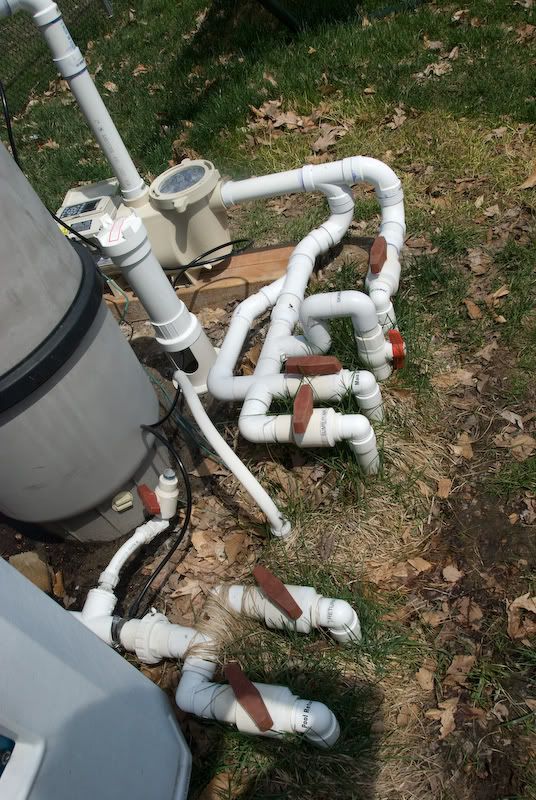
Pressure running at 35 gpm

Inlet to pump, I turned one pipe and changed things so that instead of all three 1.5" lines tying into one 1.5" line they now each go to 2" and tie together to feed the pump at 2"
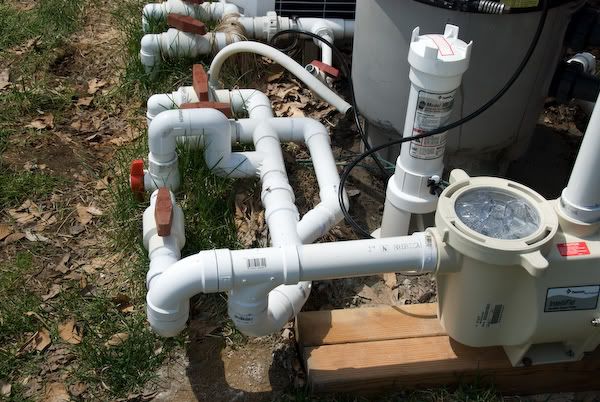
The pump outlet is the 2" horizontal line that then reduces to one inch to feed the spyer
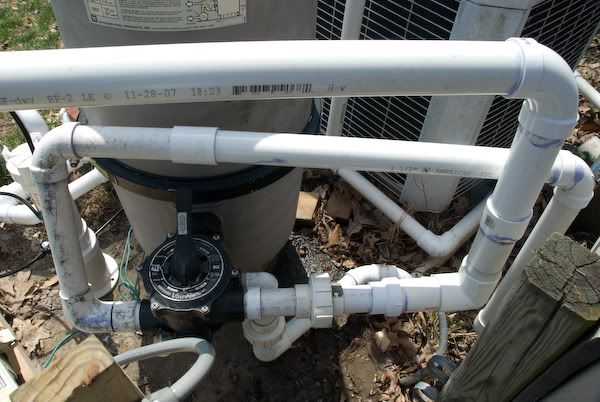
The outlet from the filter goes all through a 1.5" line and then feeds into and out of the heatpump in these next two shots. The heatpump is all actually 2" piping. Would it help to replace all the 1.5" pipe feeding in and out of the heatpump with 2" pipe? Would be a pain to do so only want to do it if it would make a significant improvement.
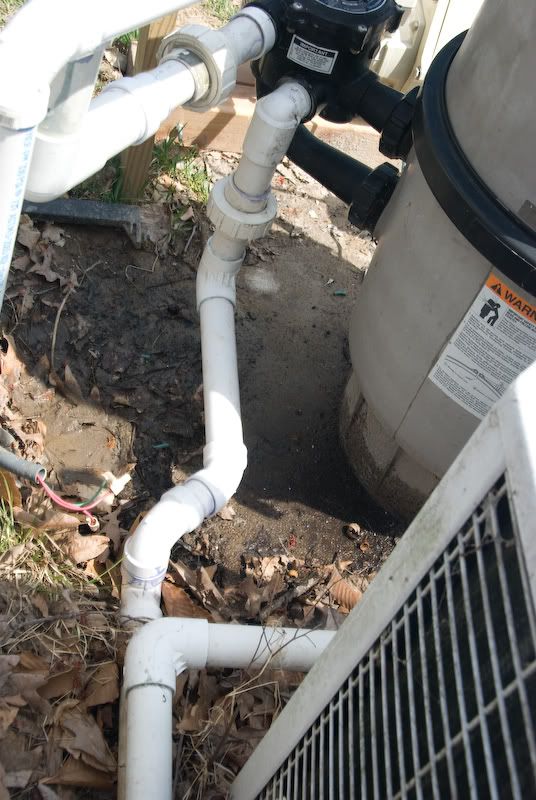
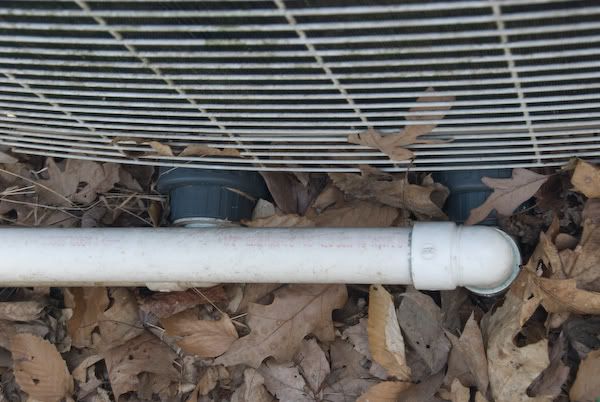
The outlet from the heatpump (1.5") travels horizontally to the two partly closed valves that lead to the eyeballs in the pool. The vertical pipe leads a side stream through a set of solar mats. That is why the return valves are partly closed to divert flow to the solar which is separate from the main flow.
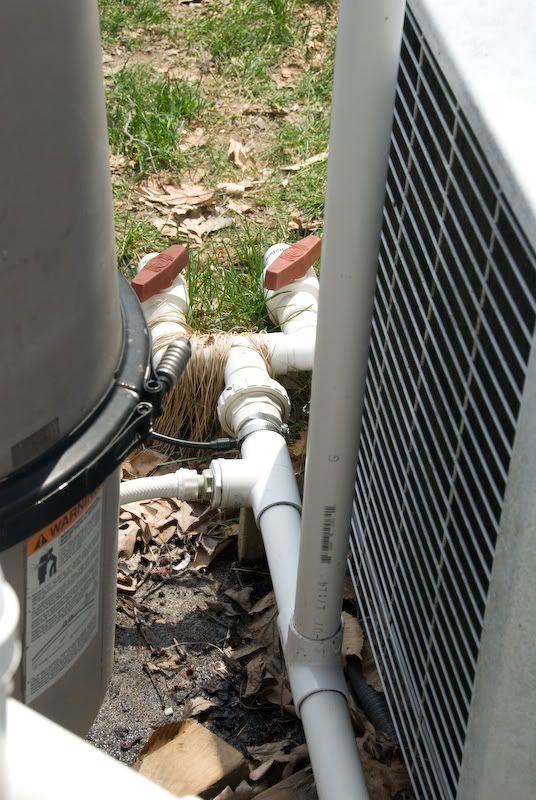
Here you can see the vertical pipe that is taking the side stream to the solar mats.
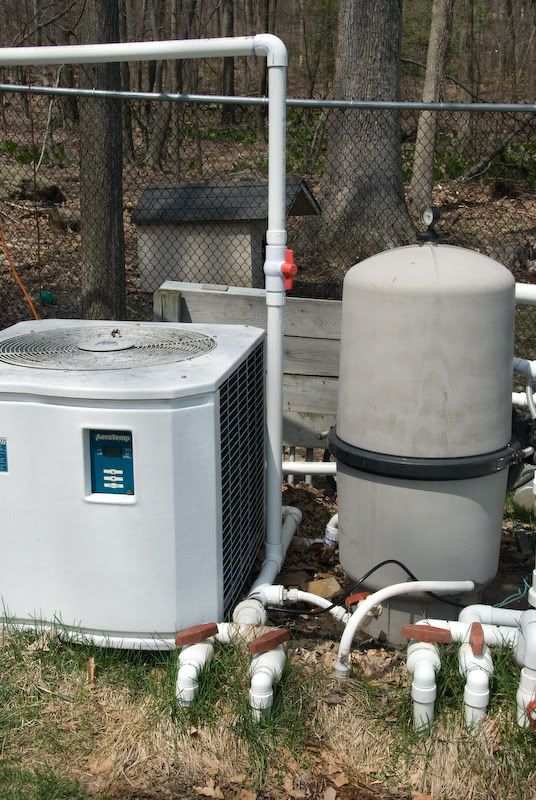
Don't think anything wrong with the filter. In fact I installed all new grids when I started it up a few days ago. Don't think it is really dirty as it has only been running for 4 days and the filter is way oversized. Last year I only backwashed it once all season.
Maybe there is a lot of loss in the heatpump? I have no idea, and there is no way to bypass it
I've included some pictures to try to explain the "nasty" piping system. The PB 10 years ago had everything at 1.5" and there was very little room to do anything.
The bottom valves are the returns to the two eyeballs in the pool and the top valves are the pipes from the two skimmers, the main drain and the first one that is closed goes to a sump under the deep end to allow ground water to be pumped to waste.

Pressure running at 35 gpm

Inlet to pump, I turned one pipe and changed things so that instead of all three 1.5" lines tying into one 1.5" line they now each go to 2" and tie together to feed the pump at 2"

The pump outlet is the 2" horizontal line that then reduces to one inch to feed the spyer

The outlet from the filter goes all through a 1.5" line and then feeds into and out of the heatpump in these next two shots. The heatpump is all actually 2" piping. Would it help to replace all the 1.5" pipe feeding in and out of the heatpump with 2" pipe? Would be a pain to do so only want to do it if it would make a significant improvement.


The outlet from the heatpump (1.5") travels horizontally to the two partly closed valves that lead to the eyeballs in the pool. The vertical pipe leads a side stream through a set of solar mats. That is why the return valves are partly closed to divert flow to the solar which is separate from the main flow.

Here you can see the vertical pipe that is taking the side stream to the solar mats.

The pressure is not normal.
1. I'd backwash. You may have algae/dirt clogging your filter
2. I'd suggest a psi guage that only goes to 50psi Cheap to do and may well give you a different reading....more accurate, as well.
1. I'd backwash. You may have algae/dirt clogging your filter
2. I'd suggest a psi guage that only goes to 50psi Cheap to do and may well give you a different reading....more accurate, as well.
You have a rather "creative" plumbing job. There are quite a few fittings there that aren't really needed. Still, none of that is probably very significant.
When you measured the pressure without the solar did you open the two valves leading to the returns all the way? If not, that would explain your pressure reading.
Switching to 2" pipe around the pad would help a little, as would simplifying the plumbing, but unless you replace the runs to the pool it would only be a small improvement. Switching to a three way valve for the solar vs pool selection would make a much larger difference, or you could open the return valves all the way every time the solar was off.
When you measured the pressure without the solar did you open the two valves leading to the returns all the way? If not, that would explain your pressure reading.
Switching to 2" pipe around the pad would help a little, as would simplifying the plumbing, but unless you replace the runs to the pool it would only be a small improvement. Switching to a three way valve for the solar vs pool selection would make a much larger difference, or you could open the return valves all the way every time the solar was off.
- May 3, 2007
- 16,820
- Pool Size
- 20000
- Surface
- Plaster
- Chlorine
- Salt Water Generator
- SWG Type
- Hayward Aqua Rite (T-15)
One more question to add to the list, is the pad significantly below the level of the pool?
If not, the only other explaination would be some sort of blockage in the return line somewhere. Your plumbing setup and equipment alone do not explain the high PSI. Something else is causing it.
If I am not mistaken, sometime DE filter grids can be installed incorrectly and cause problems like high pressure. If you cannot find anything else, then that may be a place to look.
If not, the only other explaination would be some sort of blockage in the return line somewhere. Your plumbing setup and equipment alone do not explain the high PSI. Something else is causing it.
If I am not mistaken, sometime DE filter grids can be installed incorrectly and cause problems like high pressure. If you cannot find anything else, then that may be a place to look.
duraleigh said:The pressure is not normal.
1. I'd backwash. You may have algae/dirt clogging your filter
2. I'd suggest a psi guage that only goes to 50psi Cheap to do and may well give you a different reading....more accurate, as well.
Maybe I will try backwashing, I did not pay much attention to what the pressure was when I started up (I know that was stupid) but the pool was very green so maybe the filter is plugged somewhat. As for the pressure gauge, I guess I could do that, but that does not really change what is going on.
JasonLion said:You have a rather "creative" plumbing job. There are quite a few fittings there that aren't really needed. Still, none of that is probably very significant.
When you measured the pressure without the solar did you open the two valves leading to the returns all the way? If not, that would explain your pressure reading.
Switching to 2" pipe around the pad would help a little, as would simplifying the plumbing, but unless you replace the runs to the pool it would only be a small improvement. Switching to a three way valve for the solar vs pool selection would make a much larger difference, or you could open the return valves all the way every time the solar was off.
I agree with your statement about creativity
Why would switching the solar to a three way improve anything? Ball valves full open should have almost no pressure drop.
mas985 said:One more question to add to the list, is the pad significantly below the level of the pool?
If not, the only other explaination would be some sort of blockage in the return line somewhere. Your plumbing setup and equipment alone do not explain the high PSI. Something else is causing it.
If I am not mistaken, sometime DE filter grids can be installed incorrectly and cause problems like high pressure. If you cannot find anything else, then that may be a place to look.
The pad is at the level of the pool decking, so it is about 6" or so above the water level.
I see very little change in pressure if I close one return line and then open it and close the other return line. So, I guess if there is any plugage it would have to be in both lines which seems unlikely.
As for the grids, I installed an entirely new grid assembly this year which came that way from the factory. The pressure is about the same as the old setup so I doubt that is causing it. I am really at a loss, will try backwashing.
HOLD THE FORT!!!
I think when all else fails I will need to read the manual.!!!
I have been running the pump in manual mode, as I had not yet read all the details on how to program filter mode and cycles and just wanted to get the pool running to clean it up. I have a feeling that the flow rate reading in manual mode either does not work or does not mean anything. I did backwash the filter, and it was fairly dirty and the pressures are somewhat lower now but not hugely.
But here is what I am seeing now: When I set the flow rate it always tells me that the actual flow rate is what I set it at--
15gpm 8psi 255 watt 1530rpm
20gpm 8psi 315 watts 1725rpm
25gpm 11psi 525watts 2215rpm
30gpm 15psi 840watts 2455 rpm
will not let me set flow rate under 15gpm
Now if I tell it to run at a given RPM the actual flow rate in manual mode reads zero, is that normal?
1500 rpm 260watts about 3 psi
1600rpm 305watts 5psi
Even at 1500 rpm as the setpoint there is enough flow to keep my heatpump running without tripping on low flow.
I think when I was telling it gpm in manual mode it is not showing actual gpm only the set gpm and I am not sure it is measuring correctly.
I tried it in filter mode and I think it was set to turn over 33,000 gallons in 12 or 13 hours. It showed the following:
45 gpm 1210watts 2750 rpm 19 psi on filter.
SO I GUESS IT IS TIME TO STUDY THE MANUAL. Does the pump correctly measure gpm in manual mode when you set rpm to run at? If so I may have a problem with this new pump
I think when all else fails I will need to read the manual.!!!
I have been running the pump in manual mode, as I had not yet read all the details on how to program filter mode and cycles and just wanted to get the pool running to clean it up. I have a feeling that the flow rate reading in manual mode either does not work or does not mean anything. I did backwash the filter, and it was fairly dirty and the pressures are somewhat lower now but not hugely.
But here is what I am seeing now: When I set the flow rate it always tells me that the actual flow rate is what I set it at--
15gpm 8psi 255 watt 1530rpm
20gpm 8psi 315 watts 1725rpm
25gpm 11psi 525watts 2215rpm
30gpm 15psi 840watts 2455 rpm
will not let me set flow rate under 15gpm
Now if I tell it to run at a given RPM the actual flow rate in manual mode reads zero, is that normal?
1500 rpm 260watts about 3 psi
1600rpm 305watts 5psi
Even at 1500 rpm as the setpoint there is enough flow to keep my heatpump running without tripping on low flow.
I think when I was telling it gpm in manual mode it is not showing actual gpm only the set gpm and I am not sure it is measuring correctly.
I tried it in filter mode and I think it was set to turn over 33,000 gallons in 12 or 13 hours. It showed the following:
45 gpm 1210watts 2750 rpm 19 psi on filter.
SO I GUESS IT IS TIME TO STUDY THE MANUAL. Does the pump correctly measure gpm in manual mode when you set rpm to run at? If so I may have a problem with this new pump
The pump does not really show actual flow on the pump itself unless you are setting flow (GPM) as opposed to RPM and even then it just shows what you set it to. You can SET a flow rate which it will eventually get to and you can then see the actual RPM and wattage. Or you can set an RPM, but you will not be able to know the actual flow rate by looking at the pump (in spite of an Actual Flow item in the U.I.). The only way you can see the measured flow rate is from the remote control, such as a wired control in your house connected through IntelliTouch (but then you can't be in service mode so have to not be in manual mode and instead in filter mode).
In Manual Mode, the Pentair Intelliflo VF manual says:
Note that the "Actual Flow" displays only when using flow control; that is, when explicitly setting a flow, not when setting a speed. This is unlike the "Actual Speed" that displays when either flow or speed control are used. Nevertheless, it's always appeared to me that this Actual Flow is just what you set and not a real actual flow measurement.
However, in the previous section under "Metering the System" they say:
The above is not really true, at least not by looking only at the pump. You can set various flow rates to see how things go, but if you adjust via the speed (RPM), then you can't figure out the flow (GPM) at the pump. I don't know why Pentair did this, but it's really annoying. The actual flow during normal operation is able to be seen at a control connected to IntelliTouch and I've seen that vary and "approach" the desired flow rate over time.
What I have done is either set a flow rate (GPM) and then wait about a minutes for the flow to settle (by seeing that the actual RPM or wattage stabilize) and then look at the PSI and assume the flow rate has been achieved. The other thing I've done is adjust the desired flow rate from the control panel in the house in filtering mode by adjusting the pool size and filtering time and then seen when the actual flow has stabilized. It's a pain in the rear!
The other thing that the pump does not do, yet used to be advertised that it did, was to shut off when the desired number of turnovers was achieved early due to higher flow features being turned on (such as solar panels). Part of the advertised savings from the pump was its supposed ability to keep track of the cumulative volume of water based on integrated flow and to turn off filtering early if a feature turns off and the number of turnovers has been achieved. This no longer happens -- Pentair changed the programming so that the pump is always on during the entire designated filtering time regardless of features that flow more water than filtering alone. So, the pool size, turnover rate, and filtering time settings do nothing more than calculate a flow rate to be used during the filtering time when no other features are on. When I asked Pentair about that they said that customers complained that the full filtering time wasn't being done so they changed the programming to no longer stop early. I suggested that they make this a parameter that the user can decide which mode they would prefer -- stop early if turnovers achieved or always keep the pump on for the entire filtering time.
Richard
In Manual Mode, the Pentair Intelliflo VF manual says:
• Power Menu (Watts): Displays current power to the motor shaft in continuous watts
• Actual Speed (RPM): Displays RPM speed when flow and RPM control is used
• Actual Flow (GPM): Displays actual flow when using flow control
• Set Speed (RPM): Set IntelliFlo to run at a continuous speed
• Set Flow (GPM): Set IntelliFlo in flow control to allow the pump to change speed to manage the flow rate based on system changes
Note that the "Actual Flow" displays only when using flow control; that is, when explicitly setting a flow, not when setting a speed. This is unlike the "Actual Speed" that displays when either flow or speed control are used. Nevertheless, it's always appeared to me that this Actual Flow is just what you set and not a real actual flow measurement.
However, in the previous section under "Metering the System" they say:
The first step to operating and programming IntelliFlo is to know what is being used in the
pool system. After the devices are selected you can then set valves for the appropriate
features and use the “Manual†mode to measure flow rates for the types or series of
devices that require flow. When an appropriate flow rate or rates are found for a device
or series of devices, you should note that flow rate for programming later.
The above is not really true, at least not by looking only at the pump. You can set various flow rates to see how things go, but if you adjust via the speed (RPM), then you can't figure out the flow (GPM) at the pump. I don't know why Pentair did this, but it's really annoying. The actual flow during normal operation is able to be seen at a control connected to IntelliTouch and I've seen that vary and "approach" the desired flow rate over time.
What I have done is either set a flow rate (GPM) and then wait about a minutes for the flow to settle (by seeing that the actual RPM or wattage stabilize) and then look at the PSI and assume the flow rate has been achieved. The other thing I've done is adjust the desired flow rate from the control panel in the house in filtering mode by adjusting the pool size and filtering time and then seen when the actual flow has stabilized. It's a pain in the rear!
The other thing that the pump does not do, yet used to be advertised that it did, was to shut off when the desired number of turnovers was achieved early due to higher flow features being turned on (such as solar panels). Part of the advertised savings from the pump was its supposed ability to keep track of the cumulative volume of water based on integrated flow and to turn off filtering early if a feature turns off and the number of turnovers has been achieved. This no longer happens -- Pentair changed the programming so that the pump is always on during the entire designated filtering time regardless of features that flow more water than filtering alone. So, the pool size, turnover rate, and filtering time settings do nothing more than calculate a flow rate to be used during the filtering time when no other features are on. When I asked Pentair about that they said that customers complained that the full filtering time wasn't being done so they changed the programming to no longer stop early. I suggested that they make this a parameter that the user can decide which mode they would prefer -- stop early if turnovers achieved or always keep the pump on for the entire filtering time.
Richard
Thread Status
Hello , This thread has been inactive for over 60 days. New postings here are unlikely to be seen or responded to by other members. For better visibility, consider Starting A New Thread.

